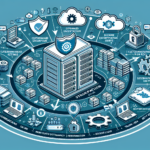Securing backup systems is critical to ensuring the integrity, availability, and confidentiality of your data. As an IT manager responsible for data center operations, here are the best practices for securing backup systems:
1. Implement Strong Access Controls
- Role-Based Access Control (RBAC): Grant access to backup systems based on roles. Only authorized personnel should have access to backup systems.
- Least Privilege Principle: Limit user permissions to the minimum necessary for their job functions.
- Multi-Factor Authentication (MFA): Require MFA for accessing backup systems to add a layer of security.
2. Encrypt Backup Data
- Data Encryption at Rest: Encrypt backup files stored on disks, tapes, or cloud storage to protect them from unauthorized access.
- Data Encryption in Transit: Use secure protocols (e.g., HTTPS, SFTP) to encrypt data during transmission between servers and storage locations.
- Key Management: Use a secure key management system to store encryption keys safely.
3. Regular Backup Validation and Testing
- Restore Testing: Regularly test backup restores to ensure data integrity and verify that the backups are functional.
- Checksum Validation: Use checksums or hash algorithms to confirm the integrity of backup files.
4. Protect Backup Storage Locations
- Physical Security: Ensure physical security for on-premises backup storage, such as locked server rooms with restricted access.
- Network Isolation: Isolate backup storage systems on a separate network segment or VLAN to reduce exposure to attacks.
- Cloud Backup Security: For cloud-based backups, ensure compliance with security standards and use secure configurations provided by the cloud provider.
5. Maintain Backup Redundancy
- 3-2-1 Backup Rule: Follow the 3-2-1 rule (3 copies of data, 2 different storage types, 1 offsite location) to minimize data loss risks.
- Geo-Redundant Backups: Store backups in geographically separate locations to protect against natural disasters.
6. Protect Against Ransomware
- Immutability: Use immutable backup storage (e.g., WORM – Write Once Read Many) to prevent backups from being altered or deleted.
- Air-Gapped Backups: Store backups offline or on isolated systems to prevent them from being compromised during a ransomware attack.
- Anti-Malware Scanning: Scan backup files for malware before storing them.
7. Patch and Update Backup Systems
- Regular Updates: Ensure that backup software, operating systems, and firmware are up to date to mitigate vulnerabilities.
- Vendor Recommendations: Follow vendor-provided security advisories and best practices for backup solutions.
8. Monitor and Audit Backup Activities
- Activity Logs: Enable logging for backup activities and regularly review logs for suspicious activity.
- Alerts: Set up alerts for unauthorized access attempts or failures in backup processes.
- Auditing: Perform regular audits to verify compliance with security policies.
9. Secure Backup Applications
- Application Hardening: Configure backup applications securely, disable unnecessary features, and ensure strong authentication.
- Firewall Rules: Restrict access to backup application interfaces and services using firewalls or security groups.
10. Backup Retention Policies
- Retention Duration: Define and enforce retention policies to ensure backups are kept only as long as necessary.
- Retention Compliance: Ensure backups comply with regulatory requirements and data privacy laws.
11. Disaster Recovery Planning
- Document Backup Procedures: Maintain detailed documentation for backup and restore processes.
- Disaster Recovery Testing: Periodically test disaster recovery plans to confirm that backup systems can recover critical data during an incident.
12. Backup for Critical Systems
- High-Priority Data: Ensure critical systems (e.g., databases, AI workloads, Kubernetes clusters) have dedicated backups.
- Kubernetes Backup: Use specialized tools (e.g., Velero or Kasten) to back up Kubernetes clusters and configurations.
13. Backup Security in Virtualized Environments
- VM Snapshot Protection: Secure virtual machine snapshots and prevent unauthorized access to hypervisors.
- Secure Storage for Virtual Backups: Protect storage systems used for virtual backups, such as SAN or NAS devices.
14. Educate Staff
- Training: Train IT staff on backup security protocols, including handling sensitive data and responding to backup incidents.
- Awareness: Provide awareness training to help employees recognize phishing attempts and other risks that could compromise backups.
By adopting these best practices, you can ensure the security and reliability of your backup systems, protect against emerging threats, and maintain business continuity.
What are the best practices for securing backup systems?

